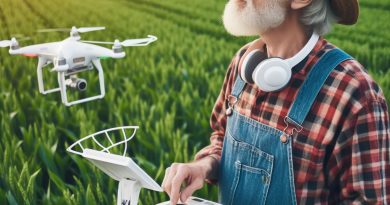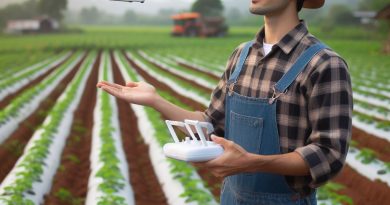Data-Driven Farming: A Closer Look
Last Updated on March 2, 2024
Introduction
Data-driven farming is revolutionizing the agricultural industry by utilizing the power of data to make informed decisions.
This blog post will explore the importance of data in modern agriculture and provide an overview of data-driven farming.
Importance of data in modern agriculture
In today’s world, data plays a crucial role in almost every industry, and agriculture is no exception.
The availability of data on weather patterns, soil conditions, crop yields, and market trends has allowed farmers to optimize their farming practices and increase productivity.
Overview of data-driven farming
Data-driven farming, also known as precision agriculture, is a farming technique that uses data analytics to make precise and efficient decisions.
It involves collecting data from various sources, such as sensors, satellites, and drones, and analyzing it to gain valuable insights.
One of the main benefits of data-driven farming is its ability to optimize resource usage.
By analyzing data on soil moisture levels, for example, farmers can apply water and fertilizers precisely where they are needed, resulting in higher crop yields and reduced environmental impact.
Data-driven farming also enables farmers to monitor crop health in real-time.
By analyzing data from remote sensors or drones, farmers can detect crop diseases or nutrient deficiencies early on and take immediate actions to mitigate them.
This proactive approach helps prevent crop losses and ensures a higher quality yield.
Furthermore, data-driven farming allows farmers to make better-informed decisions when it comes to crop planning and market predictions.
By analyzing historical data and market trends, farmers can choose the most profitable crops to grow and adjust their planting schedules accordingly.
Basically, data-driven farming is transforming the agricultural industry by harnessing the power of data to optimize farming practices and increase productivity.
By utilizing the insights gained from data analysis, farmers can make informed decisions and improve both their profitability and sustainability.
Benefits of Data-Driven Farming
Improved decision-making
- Access to accurate and real-time information: Data-driven farming provides farmers with access to up-to-date information on weather conditions, soil moisture levels, pest outbreaks, and market trends. This helps them make informed decisions.
- Precise crop management: By collecting and analyzing data on soil fertility, crop health, and growth patterns, farmers can make precise decisions regarding irrigation, fertilizer application, and pest control.
One key benefit is improved decision-making.
By utilizing accurate and real-time information, farmers can plan their operations based on the most up-to-date conditions.
For example, having access to weather forecasts can help farmers determine the best time for planting or harvesting, reducing the risk of crop losses due to adverse weather events.
Increased crop yield and quality
- Optimal use of resources: Data-driven farming allows farmers to optimize the use of resources such as water, fertilizers, and pesticides, reducing waste and increasing overall crop yield.
- Identification of growth patterns and potential issues: By analyzing data collected from sensors, satellites, and drones, farmers can identify growth patterns, detect early signs of disease or nutrient deficiencies, and take preventive measures.
In addition to improved decision-making and precise crop management, data-driven farming also contributes to increased crop yield and quality.
Optimizing the use of resources, such as water and fertilizers, based on data analysis can greatly increase efficiency and productivity.
By monitoring growth patterns and using predictive algorithms, farmers can identify potential issues early on and take timely action to prevent crop losses.
Cost reduction
- Efficient use of inputs: By using data to determine the exact amount of inputs needed for each field or crop, farmers can minimize wastage and save on costs associated with excessive use of fertilizers and pesticides.
- Minimization of unnecessary expenses: Data-driven farming allows farmers to detect areas of inefficiency, such as over-irrigation or poor machinery performance, and make the necessary adjustments to minimize unnecessary expenses.
Benefits of data-driven farming
Data-driven farming brings numerous benefits to farmers by enabling them to make informed decisions and optimize their farming practices.
Precise crop management
Precise crop management is another advantage.
By analyzing data on soil fertility, moisture levels, and pest outbreaks, farmers can tailor their crop management practices to specific areas or individual plants.
This precision allows for precise irrigation, targeted fertilization, and effective pest control, leading to healthier crops and higher yields.
Efficient use of inputs and minimizing unnecessary expenses
Furthermore, data-driven farming helps reduce costs by enabling efficient use of inputs and minimizing unnecessary expenses.
By accurately determining the precise amounts of inputs needed, farmers can avoid resource wastage and save on costs associated with excessive use of fertilizers and pesticides.
Additionally, data analysis can reveal areas of inefficiency, such as over-irrigation or poor machinery performance, allowing farmers to optimize their operations and minimize unnecessary expenses.
Generally, data-driven farming offers significant benefits to farmers, including improved decision-making, increased crop yield and quality, and cost reduction.
By harnessing the power of data, farmers can optimize their practices, minimize risks, and maximize profits, paving the way for a more sustainable and productive agricultural sector.
Read: Big Data’s Role in Future Farming
Key Components of Data-Driven Farming
Data-driven farming relies on various key components to successfully harness and leverage the power of data in agriculture.
These components encompass data collection, management, and analysis, each playing a crucial role in driving efficient and effective farming practices.
Data collection
The foundation of data-driven farming lies in the ability to collect accurate and relevant data.
Farmers can gather real-time information using sensors and Internet of Things (IoT) devices.
These devices provide valuable data on weather patterns, soil conditions, and crop growth, empowering farmers to make data-backed decisions about irrigation, fertilization, and pest control.
In addition to on-field sensors, remote sensing technologies offer more extensive data collection capabilities.
Drones equipped with cameras or multispectral sensors can capture high-resolution imagery, enabling farmers to monitor larger areas of land.
Satellite imagery can also provide valuable insights into crop health, yield potential, and pest infestations.
Data management
Data management is essential to ensure the efficient storage, organization, and utilization of collected data.
Keeping data properly categorized and easily accessible allows for streamlined analysis and interpretation.
Data storage systems, both on-premises and cloud-based, play a crucial role in securely storing large volumes of data.
Organizing data based on relevant parameters, such as location or crop type, allows farmers to retrieve specific information quickly.
Furthermore, data integration and interoperability enable seamless communication between different systems and devices, ensuring data flows smoothly across platforms.
Protecting the integrity and privacy of agricultural data is equally important.
Implementing robust data security protocols safeguards sensitive information from unauthorized access or potential cyber threats.
Farmers must also prioritize maintaining data privacy, ensuring data ownership and consent are respected when sharing with third-party applications or analytics platforms.
Data analysis and interpretation
Data analysis and interpretation are crucial steps in turning raw data into actionable insights.
By leveraging analytics tools and software, farmers can extract meaningful patterns and trends from large datasets.
Analytics tools, like data visualization software or statistical analysis platforms, provide farmers with intuitive interfaces to explore and understand their data.
These tools enable them to identify correlations, detect anomalies, and make data-driven decisions more effectively.
Optimizing farm management practices
Additionally, predictive modeling and machine learning algorithms play a significant role in optimizing farm management practices.
By identifying patterns within historical data, these algorithms can forecast future outcomes and recommend precise actions, such as optimal planting dates, irrigation schedules, or crop protection strategies.
Machine learning algorithms continuously improve their predictions by learning from newly collected data, making them valuable decision-support tools for farmers.
In a nutshell, data-driven farming relies on key components spanning data collection, management, and analysis.
Collecting accurate and real-time data through sensors and remote sensing technologies forms the foundation.
Efficient data management ensures easy access, integration, and protection of data.
Finally, data analysis and interpretation using analytics tools and predictive modeling enable farmers to make data-backed decisions, ultimately driving more efficient and sustainable farming practices.
Read: Agri-Tech and Big Data: Transforming Farm Management
Challenges and Limitations of Data-Driven Farming
Data-driven farming has revolutionized the agriculture industry by using technology to collect and analyze vast amounts of data.
However, along with its benefits, this approach also poses several challenges and limitations that need to be addressed for its successful implementation.
Data accuracy and reliability
One of the primary concerns in data-driven farming is the accuracy and reliability of the collected data.
To ensure the precision of the data, calibration and validation processes are essential.
Calibration involves adjusting and fine-tuning sensors and monitoring systems to provide accurate measurements.
Validation, on the other hand, verifies the accuracy of the collected data by comparing it with ground-truth measurements.
Both calibration and validation processes play a crucial role in removing errors and ensuring data reliability.
Data quality control is another critical aspect to consider.
The collected data needs to undergo thorough quality control checks to identify and rectify any anomalies or inconsistencies.
This process involves data cleansing, data standardization, and elimination of outliers.
Implementing robust data quality control measures helps maintain accurate and reliable data for making informed decisions in farming operations.
Accessibility and affordability
Accessibility and affordability are significant challenges faced by farmers in adopting data-driven farming practices.
Technology adoption barriers can range from lack of awareness about available tools and technologies to limited technical skills required to operate them.
Farmers may face challenges regarding the cost of acquiring and implementing data-driven practices.
Investments in hardware, software, and training to utilize data effectively can be significant, especially for small-scale farmers with limited financial resources.
Data privacy and security concerns
Data privacy and security concerns also emerge in the context of data-driven farming.
Sensitive farm data, such as field boundaries, crop yield data, and pest management strategies, need to be protected from unauthorized access.
Data breaches and unauthorized use of farm data can have severe consequences, including loss of competitive advantage or potential misuse by competitors.
Farmers must implement robust security measures and data access controls to safeguard their valuable data assets.
Furthermore, ensuring data integrity is crucial in data-driven farming.
Data integrity refers to the accuracy and consistency of data throughout its lifecycle.
Any alteration or manipulation of data can have severe consequences on decision-making processes.
Implementing mechanisms to validate and verify data integrity is essential, such as data encryption, regular backups, and audit trails.
In general, while data-driven farming offers numerous benefits, it also presents various challenges and limitations.
Addressing these challenges requires a multi-faceted approach, including proper calibration and validation of data, implementing robust data quality control measures, overcoming technology adoption barriers, managing the cost of implementing data-driven practices, ensuring data privacy and security, and ensuring data integrity.
By overcoming these challenges, farmers can harness the power of data to optimize their farming operations, increase productivity, and achieve sustainable and efficient agricultural practices.
Read: Data Analytics in Modern Farming

You Might Also Like: Soil Health Tech: Key to Sustainable Farms
Examples of Data-Driven Farming Applications
Data-driven farming, also known as precision agriculture, has revolutionized the way modern farmers cultivate their crops and manage their livestock.
By harnessing the power of data and advanced technologies, farmers can make more informed decisions and achieve better agricultural outcomes.
Precision agriculture
This is one of the key applications of data-driven farming.
Through the use of technology, such as variable rate technology, farmers can apply inputs such as fertilizers and pesticides precisely based on specific field conditions.
This targeted application not only optimizes the use of resources but also minimizes environmental impact.
Additionally, prescription maps are created using data analysis to identify areas of the field that require different levels of inputs.
By using these maps, farmers can optimize the use of fertilizers, pesticides, and water resources to achieve higher crop yields.
Livestock management
This is another area where data-driven farming has made significant advancements.
By monitoring animal health and behavior using data sensors and analytics, farmers can detect early signs of diseases or abnormalities.
This allows for timely intervention and preventive measures, reducing the risk of outbreaks and improving animal welfare.
Predictive analytics also play a crucial role in livestock management.
By analyzing historical data and real-time sensors, farmers can predict productivity patterns and make informed decisions regarding breeding, feeding, and overall management practices.
Supply chain optimization
This is an important aspect of data-driven farming.
Tracking and traceability systems enable farmers to monitor the journey of their crops from field to consumer.
This helps ensure food safety, quality control, and compliance with regulations.
Efficient logistics and inventory management systems improve the overall supply chain by optimizing transportation routes, reducing storage costs, and minimizing waste.
By utilizing data analytics and real-time information, farmers can make more efficient decisions regarding storage, transportation, and distribution.
In essence, data-driven farming offers numerous applications and benefits in the agricultural sector.
Precision agriculture improves resource utilization and crop yields, while livestock management enhances animal health and productivity.
Supply chain optimization ensures food safety and reduces waste throughout the production and distribution process.
As technology continues to advance, data-driven farming will play an increasingly vital role in sustainable and efficient agricultural practices.
Read: Smart Farming: AI’s Growing Impact
Future Perspectives of Data-Driven Farming
Adoption of advanced technologies
- Artificial intelligence (AI) and machine learning (ML) will become increasingly integral to data-driven farming. By analyzing large datasets, AI and ML algorithms can provide valuable insights and predictive models to optimize farm operations.
- The Internet of Things (IoT) will witness significant advancements, enabling seamless connectivity and communication between sensors, devices, and agricultural machinery. This connectivity will empower farmers and decision-makers with real-time data and automation capabilities.
Integration with other farming practices
- Data-driven farming can be integrated with organic and sustainable agriculture practices. Precise data analysis can aid in reducing chemical inputs, optimizing resource usage, and minimizing environmental impact.
- Regenerative farming techniques, aimed at enhancing soil health and biodiversity, can be better implemented through data-driven approaches. Analyzing soil data, weather patterns, and crop performance can aid in designing regenerative farming systems that restore and replenish natural resources.
Collaboration and knowledge sharing
- Data consortiums and partnerships will be established to promote data sharing, collaboration, and standardization. These consortia will facilitate the secure exchange of agricultural data while ensuring privacy and data protection.
- Farmers and agricultural professionals will actively share best practices, success stories, and lessons learned through data-driven platforms. This democratization of knowledge will enable farmers worldwide to learn from each other and adopt innovative techniques.
Significant benefits to the agricultural sector
The future of data-driven farming is promising, with the potential to bring significant benefits to the agricultural sector.
Adoption of advanced technologies
By leveraging advanced technologies like AI, ML, and IoT, farmers can make data-informed decisions at every stage of the farming process.
This will result in increased productivity, reduced resource wastage, and improved sustainability.
Integration with other farming practices
The integration of data-driven farming with organic and regenerative practices will pave the way for a more environmentally friendly and resilient agriculture system.
By utilizing precise data analysis, farmers can minimize the use of harmful inputs, conserve natural resources, and contribute to a healthier ecosystem.
Collaboration and knowledge sharing
Moreover, collaboration and knowledge sharing among farmers, researchers, and industry stakeholders will unlock the true potential of data-driven farming.
Establishing data consortia and partnerships will foster collaborative research, enabling the development of holistic solutions to address complex agricultural challenges.
In short, the future of data-driven farming looks promising, with a strong focus on advanced technologies, integration with sustainable farming practices, and collaboration among stakeholders.
By harnessing the power of data, agriculture can become more efficient, sustainable, and resilient, ensuring food security for future generations.
Conclusion
Data-driven farming has demonstrated immense potential to revolutionize agriculture.
By gathering and analyzing farm data, farmers gain valuable insights to optimize operations.
Soil moisture sensors show irrigation needs.
Yield monitors reveal high and low production areas.
Tracking livestock movements improves health interventions.
Every data point enables smarter decisions. The benefits already observed likely represent just the beginning.
As technology progresses, so will data collection and analysis capabilities.
The potential of data-driven farming for agriculture’s future
Future advancements could uncover connections and efficiencies we cannot yet fathom.
Data-driven farming may someday help addresses global challenges like food security and environmental sustainability.
The data-driven path holds much promise, especially for small farms lacking resources. Low-cost sensors combined with free software tools allow even struggling farmers to leverage data.
Open access platforms also promote collaboration between farmers, researchers, and policymakers.
By working together, they can accelerate innovation for the greater good.
Farmers need not feel overwhelmed or afraid of data-driven farming. Begin slowly by tracking a process that causes frustration.
Identify insights from the data and adjust accordingly.
Build knowledge and confidence over time.
With an open mind to keep learning, farmers can harness data to enhance productivity and profits while reducing uncertainty and stress.
The potential gains make it well worth exploring.


